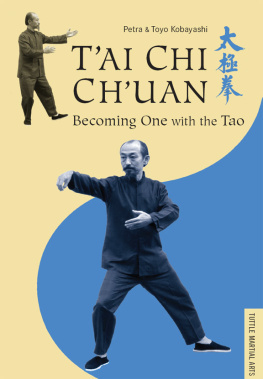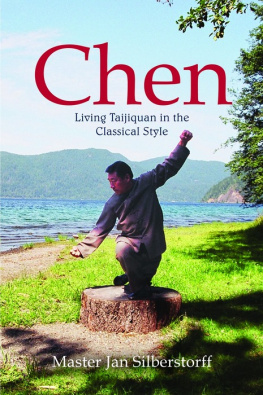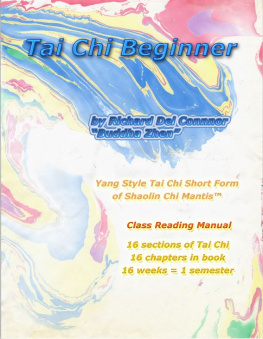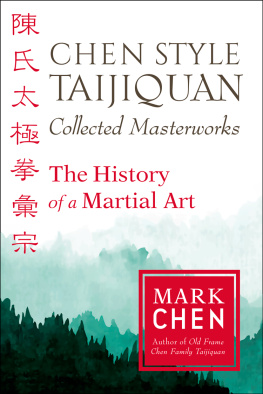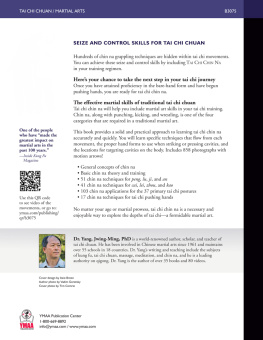Cultivating the Civil and Mastering the Martial:
The Yin and Yang of Taijiquan
Copyright 2016 Andrew Townsend
All rights reserved. No part of this book may be reproduced by any means, graphic, electronic, or mechanical including photocopying, recording, taping, or by any information storage retrieval system without the express permission of the author except in the case of brief quotations embedded in critical articles and reviews.
ISBN-13: 978-1523258536 ISBN-10:1523258535 For my teacher and friend, Dr. Jesse Tsao. Thank you for sharing your knowledge, wisdom, and experience with me and all of your students. You are a true inspiration for all practitioners of taijiquan.
Contents
Preface...................................................................................................................................................................................... i Acknowledgements ...........................................................................................................................................................vii
Preface


Hundreds of books have been written on the subject of taijiquan. Many of these books are excellent in content and provide essential information for any serious student of the art. Some were written by members of the original Chinese families responsible for developing and promoting the art and others by their close disciples. Still others have been written by serious taijiquan scholars. The bibliography that accompanies this book provides a comprehensive selection of these books.
Given the plethora of excellent books on the subject , one might question the necessity of yet another book. The motivation for this book arose from my many years of experience in the taijiquan community. Sadly, my experience has been that most of the teachers and students with whom I have had contact do not embody the true essence of the art. The unique contribution of this book is to foster an understanding of the vital core of the art of taij . iquan.
Many Occidental teachers teach the form and talk about concepts such as song qi , the dantien , and the balance of yin and yang. However, in most cases their understanding of these important principles is conceptual rather than experiential. If
teachers dont embody these important qualities, how can their students ever hope to incorporate these principles and
qualities into their own practice?
The current state of affairs is that most Occidental teachers (and many Chinese teachers as well) spend a limited time studying with this or that master and then establish themselves as teachers in their own right. It is now possible to attend a week-long or even a weekend workshop where one can become certified as a taijiquan instructor.
These so-called teachers may know the form and may have a passing familiarity with the underlying principles of taijiquan, but they have not invested the time and effort ( gongfu ) necessary to develop a deep understanding of taijiquan and, more importantly, to embody the essence of the art in their own practice. In this way, the true art of taijiquan has become diluted to the point that very few people practice the art correctly. Without proper instruction and guidance, the general level of
taijiquan that one encounters today is of a very low caliber.
This is true in both empty-hand forms and weapons forms and also in pushing hands. You only need attend a local or even a national Chinese martial arts competition to see how diminished both the form and pushing hands have
i
become. Gold medalists perform the form with little or no regard for the underlying principles established by the originators of the art: their knees extend forward past their toes; their heads move one way while their torso moves another; they bob up and down like buoys in a choppy sea; and nowhere is seen the movement of qi or the underlying expression of jin .
As if the form competitions arent bad enough, just walk over to the area set aside for pushing hands competition. There you will see the participants shoving and grappling like junior varsity wrestlers, sweat popping out on their foreheads and staining their shirts. The idea of four ounces deflecting a thousand pounds flies out the window at the first contact between the two participants. The principle of yielding oneself to follow the other is nowhere to be found. The first player to shove the other out of the circle wins; thats all there is to it.
The root cause of this dilution of the art is the manner in which taijiquan is taught today. The reality is that the true heart of any style of taijiquan cannot be conveyed in a classroom setting. Even a high-level taijiquan master cannot transmit the essential knowledge of his art to a large group of students. The reasons for this are varied. First, the instruction must be tailored to each individual student depending upon his or her ability and level of development. Second, not all students are worthy of receiving the essence and true transmissions of the art. The old expression, casting pearls before swine, is apropos here. Lastly, true qi circulation and jin power must be demonstrated and subsequently transmitted directly from master to disciple. This clearly cannot be accomplished in a group setting, even if the students are all adept and open to receiving this transmission.
Even highly-developed teachers with a direct lineage relationship to one of the original taijiquan families can only transmit the full extent of their knowledge and skill to a very limited number of close disciples. This special relationship with their masters establishes such disciples as indoor or inner courtyard students. This term is bestowed upon them because they have been invited into the home or the courtyard of their teacher for private and sometimes secret instruction. Such special status is often limited to family members or trusted individuals close to the family. It is very rare for a Westerner to be accepted as an indoor student.
I have been fortunate to have studied with a number of excellent Western and Chinese teachers. Of all these excellent teachers, however, two individuals have had the most profound impact on my understanding and practice of taijiquan They are Master James Huang of Honolulu and Grandmaster Jesse Tsao of San Diego. Each, in his own way, has provided me with the general understanding and insights as well as specific instruction and guidance that can only come from a personal relationship.
I had the great fortune to meet and study with Master Huang more than twenty years ago. At that time he was not offering formal classes in taijiquan. Instead, he was a well-respected practitioner of traditional Chinese medicine and gained his livelihood from treating his many patients, a practice which he continues to this day. Master Huang studied with one of Professor Cheng Man-chings indoor students in Taiwan. He subsequently moved to Honolulu, where he continues to practice and teach the Cheng Man-ching 37 posture form, which emphasizes relaxation and qi circulation. Master Huangs cultivation of qi and skill in pushing hands is of a very high level. At that time, I had not experienced anything that compared with Master Huangs skill and depth of understanding of the underlying principles of taijiquan
Next page

